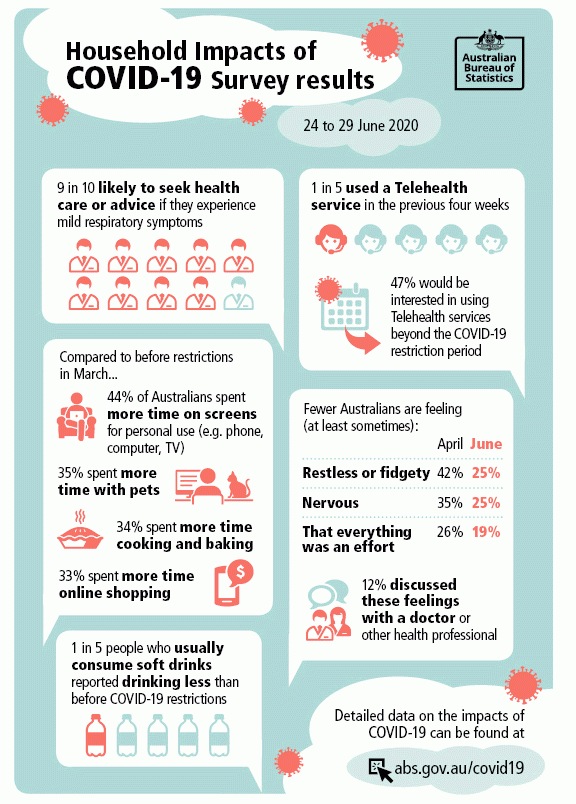About this issue
This publication presents results from the seventh Household Impacts of COVID-19 Survey, a longitudinal survey which collects information from approximately 1,000 people fortnightly via telephone. This cycle was conducted between 24 June and 29 June 2020.
The seventh cycle collected information on:
- personal and household stressors
- feelings of emotional and mental wellbeing
- lifestyle changes
- precautions taken due to COVID-19
- use of Telehealth services
- likelihood of seeking health care or advice for respiratory infections
- extent of disruption to services for people with a disability
- whether people intend to move in the next year
- job status.
The scope of the survey was persons aged 18 years and over in private dwellings across Australia (excluding very remote areas).
About this collection
This survey is designed to provide a quick snapshot about how Australian households are faring in response to the changing social and economic environment caused by the COVID-19 pandemic. Each cycle has collected information on different topics.
Results from the earlier Household Impacts of COVID-19 Surveys can be found using the following links:
- Household Impacts of COVID-19 Survey 1–6 Apr 2020 (released 20 Apr)
- Household Impacts of COVID-19 Survey 14–17 Apr 2020 (released 1 May)
- Household Impacts of COVID-19 Survey 29 Apr–4 May 2020 (released 18 May)
- Household Impacts of COVID-19 Survey 12–15 May 2020 (released 29 May)
- Household Impacts of COVID-19 Survey 26–29 May 2020 (released 15 Jun)
- Household Impacts of COVID-19 Survey 10-15 June 2020 (released 29 Jun).
At the time of the survey, initiatives in place to help reduce the spread of COVID-19 and support the economy included:
- international travel restrictions
- an economic stimulus package (12 March)
- border control measures for some states and territories
- shutting down of non-essential services and a second economic stimulus package (22 March)
- a Coronavirus Supplement announced on 22 March, to be paid fortnightly from 27 April to eligible income support recipients along with their usual payments
- a safety net package of $1.1 billion to expand mental health and Telehealth services, increase domestic violence services and provide more emergency food relief (29 March)
- social distancing rules and additional shutdown restrictions (20–30 March)
- free childcare for working parents (2 April)
- a JobKeeper Payment passed in legislation on 15 April and paid to employers to keep more Australians in jobs and support businesses affected by the COVID-19 restrictions
- easing of restrictions on elective surgery gradually from 28 April
- National Cabinet agreeing on a three-stage plan to ease restrictions (8 May)
- easing of restrictions in all states and territories from mid-May, with all in stage 2 and some in stage 3 at the time of the survey.
Most states and territories either had no cases or small numbers during enumeration. Cases of COVID-19 had begun to rise again in Victoria with 15 to 20 cases per day in the week before and numbers rising to 75 new cases on the final day of enumeration. New South Wales was recording between five and ten cases daily at the same time.
Proportions marked with an asterisk (*) have a Margin of Error (MoE) >10 percentage points which should be considered when using this information. For more information about MoE refer to the publication Methodology.
